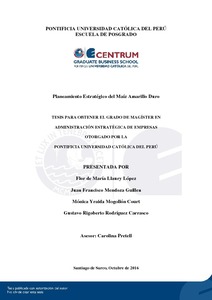| dc.contributor.advisor | Pretell Pardo, Ángela Carolina | |
| dc.contributor.author | Llaury López, Flor de María | es_ES |
| dc.contributor.author | Mendoza Guillen, Juan Francisco | es_ES |
| dc.contributor.author | Mogollón Court, Mónica Yraida | es_ES |
| dc.contributor.author | Rodríguez Carrasco, Gustavo Rigoberto | es_ES |
| dc.date.accessioned | 2017-03-15T17:02:46Z | |
| dc.date.available | 2017-03-15T17:02:46Z | |
| dc.date.created | 2016 | |
| dc.date.issued | 2017-03-15 | |
| dc.identifier.uri | http://hdl.handle.net/20.500.12404/8204 | |
| dc.description.abstract | En los últimos 10 años, la producción de maíz en Perú ha crecido casi a 3.7% anual,
llegándose a producir en el año 2015, un 1’750,000 TM, en las variedades de maíz amarillo
duro (MAD) y maíz amiláceo.
El MAD es utilizado principalmente como materia prima para elaborar alimentos
destinados a la industria avícola y porcina, y es producido por pequeños agricultores y
criadores de aves. En cambio, el maíz amiláceo está destinado al consumo humano, cuyos
cultivadores primero satisfacen la demanda alimenticia de sus familias y los excedentes son
vendidos a los acopiadores.
Luego de cubrir su demanda interna de maíz amiláceo, el Perú tiene excedentes que
son exportados. Sin embargo, no ocurre lo mismo con el MAD, cuya producción nacional no
cubre la demanda interna, por lo que debe ser importado. Esto, pese a que el país tiene
disponibilidad de climas y suelos donde podría producirse mayor cantidad de dicho tipo maíz,
que incluso es de mejor calidad que el importado.
El propósito del presente documento es desarrollar el Plan Estratégico del MAD, para
lograr que al año 2030 la demanda local sea casi abastecida por la producción nacional. Para
ello, se seguirá el modelo secuencial del proceso estratégico, que tiene tres etapas: (a)
formular las estrategias necesarias para llevar a esta industria a la situación futura deseada,
estableciendo la misión y la visión con miras al año 2030; (b) implementar las estrategias; y
(c) evaluar y controlar, para monitorear las etapas secuenciales.
Luego de desarrollar el Plan Estratégico del MAD, se concluye que sí es posible
incrementar el abastecimiento al 50% de la demanda local. Para ello, se debe potencializar el
uso del MAD híbrido para mejorar el rendimiento y eficiencia en costos de producción, y
utilizarlos según las características geográficas y climatológicas de cada región.
Asimismo, se debe potenciar el uso de la tecnología para la producción, sobre todo en
las regiones que tienen bajo rendimiento como la selva alta, la selva baja y parte de la costa
norte. A su vez, es necesario aprovechar nuevas tierras de cultivo, principalmente en la región
amazónica | es_ES |
| dc.description.abstract | In the last 10 years, the production of corn in Peru have grown in 3.7% annual,
reaching to produce in 2015, one million seven hundred fifty thousand tons, in the varieties of
yellow and amylaceous corn.
Yellow corn is used mainly as raw material to elaborate food in the poultry and swine
industry, and it is produced by small farmers as breeders of birds. The amylaceous corn
instead, which is mainly used for human consumption, the ones are produced by farmers that
satisfy the demand of their families, and the surplus are sold to the collectors.
After covering the internal demand of the Amylaceous Corn, Peru has surpluses that
are exported, however it does not happen the same with the yellow corn which national
production does not cover domestic demand, which it must be imported. This, in despite of
the country has availability of weather and soil, where it can be produced more quantity of
this type of corn with it has better quality than the imported one, even.
The purpose of the present document is to develop the Strategic Plan of the Yellow
Corn in order to get that at 2030 the domestic demand it is almost covered by the national
production. For that it will be followed the sequential model of the Strategic Process that has
three steps (a) formulate the needed strategies to take this industry to the desired situation,
stablishing the mission and vision to the 2030; (b) implement the strategies and (c) evaluate
and control to follow up the sequential process.
After developing the Yellow Corn Strategic Plan, it is concluded that it possible to
increase the provisioning to the 65.2% of the domestic demand. As for that, the use of Hybrid
Yellow Corn in order to improve the yield and efficiency in production costs and use them
according to the geographical and climatological features of each region.
Also it must be enhance the use of the technology for the production, over all in the
regions that has low yield as the high jungle, the low jungle and part of the north coast. Also
it is necessary to take advantage of the farmland mainly in the jungle region | es_ES |
| dc.language.iso | spa | es_ES |
| dc.publisher | Pontificia Universidad Católica del Perú | es_ES |
| dc.rights | info:eu-repo/semantics/openAccess | es_ES |
| dc.rights.uri | http://creativecommons.org/licenses/by-nc-nd/2.5/pe/ | * |
| dc.subject | Maíz | es_ES |
| dc.subject | Planificación estratégica | es_ES |
| dc.title | Planeamiento estratégico del maíz amarillo duro | es_ES |
| dc.type | info:eu-repo/semantics/masterThesis | es_ES |
| thesis.degree.name | Maestro en Administración Estratégica de Empresas | es_ES |
| thesis.degree.level | Maestría | es_ES |
| thesis.degree.grantor | Pontificia Universidad Católica del Perú. CENTRUM | es_ES |
| thesis.degree.discipline | Administración Estratégica de Empresas | es_ES |
| renati.discipline | 413307 | es_ES |
| renati.level | https://purl.org/pe-repo/renati/level#maestro | es_ES |
| renati.type | https://purl.org/pe-repo/renati/type#tesis | es_ES |
| dc.publisher.country | PE | es_ES |
| dc.subject.ocde | https://purl.org/pe-repo/ocde/ford#5.02.04 | es_ES |






